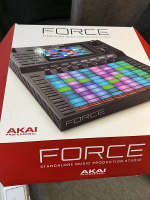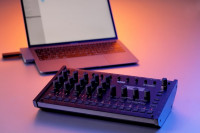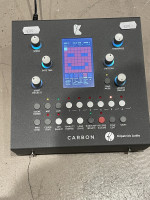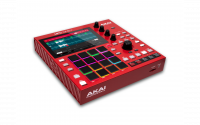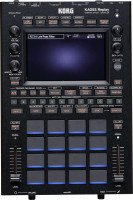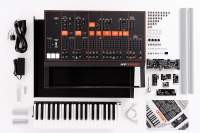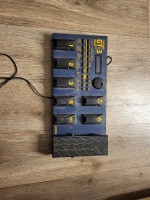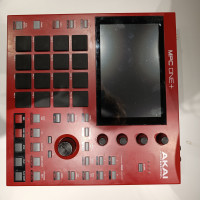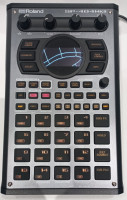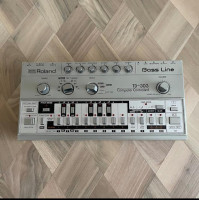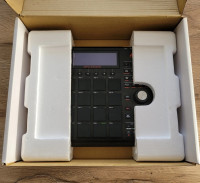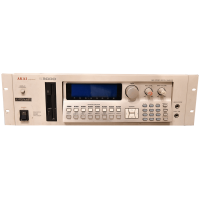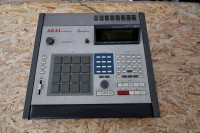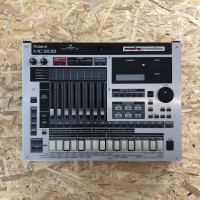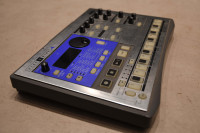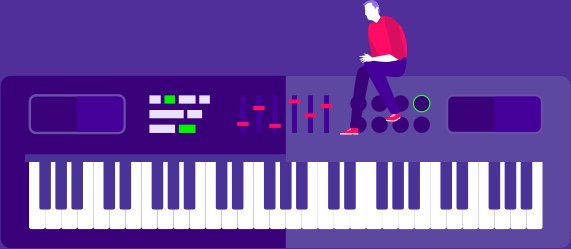
Sampler & Sequencer
The masterpiece of many producers.
48 results
Order By :

Yamaha
MODX7
SOUND SYNTHESIZERSAWM2Reserved for Yamaha synthesizers, the AWM2 engine offers much more than just sample playback. Each of the 16 AWM2 Parts includes eight fully programmable synthesizers with their own dedicated filter (18 different types!), amplitude, pitch and filter envelope generators, nine LFOs, a 3-band EQ and a block of two dedicated effects with Virtual Circuitry Modeling technology.FMXFM-X is a highly sophisticated synthesis engine capable of producing classic 80's sounds or the most cutting-edge FM sounds for today's EDM music with incredible dynamics, power and definition. MODX features an 8-operator FM architecture and 64-note polyphony, offering a wide range of options for sound creation.SEAMLESS SOUND CHAININGSeamless Sound Switching (SSS) technology allows you to seamlessly switch between performances without any envelope or effect cuts*. It's perfect on stage for ending one track and moving straight into the next.192-NOTE POLYPHONYMODX features 128-note stereo polyphony for the AWM2 engine and 64-note polyphony for the FM-X engine. Due to the unique architecture of MODX and MONTAGE, this polyphony is always available without latency or impact on other features.POWERFUL EFFECTSFrom high-definition reverb algorithms to effects modeled down to the smallest component (VCM effects), MODX is loaded with innovation and DSP power, with sound quality that's off the charts. Use effects such as Beat Repeat, Vinyl Break or Bit Crusher to achieve an EDM sound. The Spiralizer effect creates the auditory illusion of an infinitely rising or falling pitch.You can even add a compressor with sidechain for a modern ducking effect. Or revisit the past with vintage effects such as Analog Delay, VCM Phaser or a variety of amp simulators. Pianists will appreciate piano-focused effects like Damper Resonance for a realistic piano experience, as well as HD reverbs that allow you to place yourself in any physical space.SIDECHAINAutomatically controlling the dynamic behavior of one Part in relation to another, "Sidechain" is very popular in modern dance music where a pad or other pad is slaved to the bass drum. When the bass drum is played, it reduces the level of the Part by creating a rhythmic "pump" effect.BUILT-IN FLASH MEMORYMODX includes 1GB of non-volatile user flash memory with high-speed read/write for loading your own samples or sound banks downloaded, for example, from yamahamusicsoft.com.ANALOG INPUTS AND AUDIO INTERFACEWith its two analog and digital inputs, MODX becomes the center of your recording studio or on-stage computer device.As today's computer-based music production demands, MODX features a professional 4-in/10-out multi-channel USB audio interface. A single cable connection replaces the need for an external audio interface. Class Compliant, it is iOS compatible.TOTAL CONTROLAn artist needs their own signature sound. Take control and stand out. Bring the sophistication of music production automation to your live performance with Motion Control.The Super Knob allows you to control up to 128 parameters simultaneously in a single performance. That means you can control virtually everything from the mix with levels, pans and effects sends to the smallest of synthesis parameters such as filters, LFOs and operators.That's 128 parameters... SIMULTANEOUSLY!The Super Knob can even be assigned to an FC7 expression pedal, making it easy to manipulate the sound and bring incredible expressiveness, while keeping both hands available for keyboard playing.MOTION SEQUENCESMotion Sequences are fully customizable, tempo-synchronized sequences of control data that can be assigned to virtually any synthesizer parameter, providing unique ways to create evolving and expressive sounds.These Motion Sequences also have dedicated controls on the front panel, making them easy to manipulate and edit live, allowing for exceptional interactivity and expression.ENVELOPE FOLLOWERThe envelope follower converts audio into a control source that can affect virtually any synthesizer parameter. For example, a drum loop can drive effect parameters for a pleasing rhythmic feel, or a vocal recording can control multiple parameters for a "talking" synthesizer. The audio can even be a live source plugged into the analog input.AUDIO BEAT SYNCABS (Audio Beat Sync) detects the beats of an external device connected to the analog input such as an electronic drum kit, vintage drum machine or audio player, and synchronizes the MODX Arpeggiator, Motion Sequencer and Songs to the tempo of the external input. The MODX synthesizer "listens" to the live music and matches it!CUBASE AI BUNDLEThe Yamaha MODX comes bundled with Cubase AI, Steinberg's professional music production software for recording, editing and processing on Windows and Mac PCs.
1 350,00 €
1 606,00 €
-16%
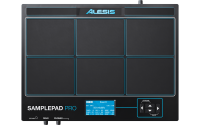
Alesis
Samplepad Pro
With SamplePad Pro, there’s no limit to your sonic creativity. SamplePad Pro is the all-in-one percussion instrument that knows no bounds. It features 8 fully responsive and velocity sensitive pads with blue LED illumination. There are hundreds of professionally recorded in-demand sounds onboard, and a SD card slot for loading and storing your own custom sounds. In short, SamplePad Pro is everything you’re looking for in a multi-pad—and more.With SamplePad Pro, there’s no limit to your sonic creativity. Over 200 carefully-crafted drum, cymbal, and percussion sounds are built-in—each created by the professional Alesis sound design team. These sounds are arranged into ten onboard preset drum kits for instant access during performance. You can also use an SD card (up to 32GB, not included) to store an additional 512 of your own sounds and 89 custom kits. Plus, each sound offers individual access to key parameters such as pitch, panning, and reverb for customized control. The user interface is intuitive and fast--- editing and loading your own sounds is quick and easy, even during live performances!
249,00 €
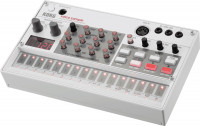
Korg
Korg Volca Sample
Sequence and modify your samples easily. The Volca Sample allows you to read and modify your samples easily. You can also create rhythmic or melodic patterns with the integrated sequencer directly from the famous Electribe series. Is it useful to boast more about its qualities?
136,99 €
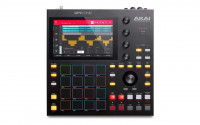
Akai Pro
MPC One
STEP UP TO STANDALONEMPC One is a total music production solution to take your ideas from concept to finalized radio-ready beats.FULL MPC EXPERIENCEDon’t let the size fool you. The MPC One packs a lot of features and workflow tools into ONE powerful punch. Beat programming, editing, mixing FX and instruments and so much more means an uncompromised creative experience.FULL CONTROLMPC ONE delivers a truly empowering hands-on experience, ready for any music production task. Edit and trim samples with hand gestures on the brilliant 7” touch screen display. Express your ideas perfectly with the assigned knobs and touch keys that eliminate diving through pages of menus.STUDIO CONNECTIVITYMPC One integrates into your creative space with all the ports and jacks you need. USB, MIDI DIN, CV/Gate, and 1/4” line-level audio input. With USB and SD card slots, you can save, transfer and share your music.PRO PERFORMANCE & TECHNIQUESYour favorite music production techniques come standard on MPC One. Tape Stop effect, Note Repeat for pulsing hi hats, and 16 Levels to play those melodic 808s plus many more.INCLUDES MPC DESKTOP SOFTWAREAkai Professional's next generation standalone, multi-core powered MPC Series features MIDI Multi capability, transforming MPC into the ultimate MIDI sequencing studio center piece. Now you can simultaneously connect and route all the MIDI gear in your studio including class compliant USB Keyboards, MIDI interfaces and USB to CV modules, supercharging your I/O capability. Fuse this with deep internal MIDI routing capability across tracks, comprehensive MIDI routing to any MIDI compatible synthesizer, drum machine or sound module, and even multitrack recording capability, and MPC forms the beating heart of any production setup, unleashing the true power of all your gear.
669,00 €

Korg
SQ64
The SQ-64 is an incredibly powerful and compact polyphonic step sequencer with convenient intuitive controls and extensive editing options to give you the flexibility and sequencing power you need for all your musical projects.With its 64-step matrix keyboard, beautiful OLED display, sturdy and elegant aluminum case, numerous connections, and variety of modes and functions, the SQ-64 will become the centerpiece of your music studio, giving you complete and seamless control of all your instruments so you can focus on what matters most: your music!
298,00 €
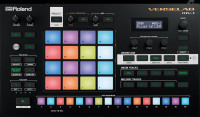
Roland
Verselab MV-1
In need of inspiration? VERSELAB helps you capture, refine and realize your ideas. Practice is made easy with modern vocal recording, pattern generators, thousands of ZEN-Core sounds, mastering effects, and more.Whether you're a singer or a beatmaker or both, Verslab makes it easy and simple to create and compose your songsVERSELAB is designed for modern music creation and vocal recording. The high-quality XLR microphone input makes it easy to record vocals with built-in effects like Auto-Pitch, Harmonizer, Doubler and more. Just plug in a mic, dial in the sound, and go. With 16 easy-to-access jacks and the ability to copy them anywhere in your song, arranging is a breeze.VERSELAB is compact, portable and battery-powered. Collaborate in person or remotely by sharing projects or using Zenbeats' cloud storage features. When your song is ready, mix and master directly from VERSELAB, then connect your mobile device and upload to your favorite music platform or social channels.
585,00 €
639,00 €
-8%
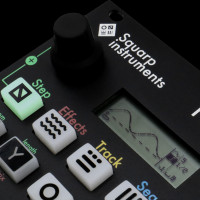
Squarp Instruments
Hermod
Hermod modular brainThe 8-track sequencer & interface for your eurorack system.Perfect for composition and live performances :Hermod brings together an advanced step sequencer, a CV looper, a real-time effect processor, LFO generators and a complete bi-directional MIDI-USB-CV input/output interface.Record a performance at any time thanks to the CV inputs, the USB HOST, the USB DEVICE and the MIDI input, quantized or not. Create and edit your tracks with the STEP mode and its piano roll & automation view. Generate crazy patterns with the randomization tool.Hermod is polymetric, it means that each track can have a different length, from 1 step to 64 steps. Moreover, you can zoom in to increase the resolution of the step sequencer (up to 512 steps).Dynamic effects :All the fun in Hermod resides in its effect system, allowing you to transform input signals, whether it's MIDI or CV. You can stack on each track up to 8 real-time effects: Quantize, Swing, Arpeggiator, Ratchet, Random, Euclid, Glide, Harmonizer, Delay, Chance, Scale, LFO... Experiment with the effects position and parameters to generate groovy rhythms and eccentric melodies!Every effect parameters can be edited in the EFFECTS mode, or with midi CC messages & CV inputs, thanks to the modMatrix.Polymorphic tracksThanks to Hermod architecture, a track can be a simple mono CV/GATE voice, but can be easily configured as a polyphonic track (up to 8 voices), a CV/GATE + velocity + aftertouch track, a modulation + clock track... in order to perfectly fit your eurorack system!Sequences and Projects :The 8 tracks are grouped into one of Hermod’s 8 sequences. Every sequence is totally independent and contains a new set of tracks to be played with, for a total of 64 tracks in a single project. The number of projects is unlimited and the save/load can be done quickly without losing the tempo, allowing you to jump from one song to the next in your live performance.Cv/Gate - Midi - USB interface :Full connectivity: control Hermod with plug-and-play midi USB devices, midi keyboards, computers or other eurorack CV systems. Hermod is also a great midi hub, allowing you to sequence midi synthesizers/drum machines and computer's virtual instruments. Of course, Hermod can be perfectly paired with Pyramid or other hardware and software sequencer, in order to benefit from its CV/GATE outputs.With Hermod's rock-solid clock, this module becomes a great synchronization tool for all your setup! Thanks to its powerful CPU, even when synced, Hermod allows an ultra-low latency to make the perfect link between the digital world and the analog world.
459,00 €
469,00 €
-2%
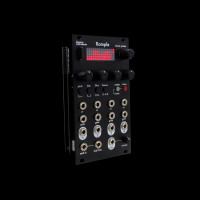
Squarp Instruments
Rample
Rample waves systemEurorack 4-voice sample player & audio processorVersatile sample machine :From percussive drum-machine kits to synth samples, breakbeats to sound FX, backing tracks to hour-long audio music, Rample can play up to 4 .wav files on independent audio outputs :These samples are stored inside the provided SD card, and organized as kits, from A00 to Z99... allowing up to 2600 banks of 4 voices, with on-the-fly loading! The SD card is preloaded with tons of samples, and we made it very easy to import your own kits.Thanks to the DC coupled audio outputs, it's also possible to play CV waveforms. Effects rack :Each voice has its own “rack” of effects, and all audio effects can be enabled at the same time, allowing you to manipulate your samples in real time, from a gentle lowpass to massive destruction!pitch - a great sounding pitch engine, based on a 6-pole interpolator, which ranges from -1 octave to +1 octave.bits - two different bitcrushing algorithms, based on sample rate and resolution reduction. It produces distortion and warms the audio signal.filter - a low resonance filter, DJ-style, cutting off the high frequencies or the low frequencies.freeze - sample and loop a fraction of the played waveform, creating a glitching effect.levels - decrease the gain or drive the signal.It’s also possible to edit ‘advanced parameters’ like the start point, sample length, attack/decay and run mode, and create mute groups without breaking a sweat.Finally, thanks to the 4 CV inputs, any of the effects (or advanced parameters) can be assigned to create amazing modulations!Multi-layer sampling :One of the key feature is the ability to "multi-sample" your kits, multiplying Rample’s potential. Each voice supports up to 12 samples, can be played randomly or in a controlled fashion. It’s a great way to add complexity and variations, to create organic/acoustic sounding drums, or simply to increase the number of samples per kit (up to 48).As an example, we are providing a multi-layered drum kit, with 12 different recordings of a kick, 12 different recordings of a snare, etc. Sequencing them randomly leads to a more natural drum playing.We are also providing an other kind of multi-layered acoustic drum kit, where each drum is recorded with 12 levels of velocity. Controlling the layer to be played leads to intricate, convoluted drums programming.Of course, it’s very easy to create your own multi-layered kit, and you can use this method to perform multiple synth chords, sound glitches, voices, breakbeats...CV/Gate and Midi interface :Rample is designed to be the perfect rhythmic companion of your eurorack system thanks to its Gate (trig samples) and CV (modulate samples) connectivity.You can also use it as a standalone midi machine, without using the CV/Gate connectivity: the midi in port allows you to trig & control all samples parameters + effects values at the same time. Each Rample comes with a ‘stereo jack to midi DIN’ and ‘stereo jack to jack’ adapters, easing the chaining of multiple modules in order to create an 8-voice, 12-voice, 16-voice (or more) midi drum machine!
320,00 €
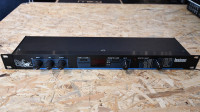
Dynacord
Reflex Dynamic Midi Reverberator
For many people, Lexicon is the definitive brand name for digital reverberation units. With the EMT, Lexicon dominated the market in the 1980s, producing realistic reverberation simulations in a variety of formats ranging from simple rack-mount units like the PCM70 and Lexicon 200 to high-end units with LARC remotes, including the 224XL and 480L. Following their initial success, Lexicon developed its own digital reverb processor, the Lexichip, which allowed them to build cheaper and more compact effects processors. A new version of this processor, the Lexichip II, gave birth to the Lexicon PCM 80 and Reflex. The Reflex is not only a reverb processor. It has a wide variety of programs and, unlike the Alex, a complete Midi specification allowing real-time control of parameters via Midi. Lexicons as old as the PCM70 offer Midi control, but the Reflex is the first to be offered in this price range. The Reflex is designed to be fast and easy to use with 16 presets and 128 user memories (Alex: 16 memories). The front panel is very simple with a signal LED, Input / Mix / Output controls, (Mix varies the mix of effect and dry signal), a Store / Clear button, a Parameter / Learn button (to select the parameter to be edited or to enter APM - Advanced Programming Mode), a Value button (to edit this parameter), a digital display and a Register / Preset button to select a program. The Learn function allows you to patch the Midi signals to control a parameter. Enter APM mode by pressing and holding the Parameter / Learn button, select the parameter to be controlled, send a Midi message and the assignment is made. Each preset has up to 10 parameters that can be edited (Alex: 3), two from the front panel and the rest via the APM. The edited programs can be saved in one of the 128 user memories.
149,00 €
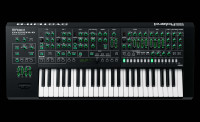
Roland
System 8
SYSTEM-8 is the result of more than four decades of synthesizer research and development at Roland, a legacy that has produced legendary instruments. SYSTEM-8 perfectly reproduces the sound and behavior of three of our most coveted classics, the now original JUPITER-8, JUNO-106, and JX-3P-but it opens up many more possibilities. Combine modern and vintage oscillators and filters with a variety of dedicated effects, then split and layer the sounds to create unbelievable tones. Fine-tune every nuance with countless high-precision controls, and perfectly render your musical ideas with the internal polyphonic sequencer and control movement recording.SYSTEM-8's architecture is based on a long tradition of research and development, and features authentic models of classic oscillators, filters and effects. It even recreates components from JUPITER-8, JUNO-106 and JX-3P, not to mention the legendary synth sounds available on the Roland Cloud. But the SYSTEM-8 goes far beyond vintage. It features a palette of digital and analog oscillators with Saw, Square, Triangle, SuperSaw, SuperSquare, SuperTriangle, FM and other unique waveforms. Among the filters, it has the famous JUPITER and JUNO filters as well as newer types including the fascinating sideband filter. If you're wondering what a controller-laden FM synth with a JUPITER-8 filter sounds like, now is the time to find out. Capable of splitting, layering and combining different synth engines, SYSTEM-8 is uniquely versatile, going from crystal clear to thunderous and from delicate to breathtakingly punchy with a few high resolution controls.SYSTEM-8 features three expansion ports to accommodate and control PLUG-OUT synths, 100% authentic, full-featured models of Roland classics that you can swap out at will. The JUPITER-8, JUNO-106 and JX-3P PLUG-OUTs are included, and you can combine the native synth generator with the plugged-in PLUG-OUTs to create super synth patches based on layered voices and custom splits. JUNO-60, SH-2, SH-101, PROMARS, SYSTEM-100 and many others form the ever-growing collection of PLUG-OUTs on Roland Cloud, all of which also function as plug-ins controllable from the SYSTEM-8 control panel.
1 490,00 €
1 499,00 €
-1%

Yamaha
MODX8
SOUND SYNTHESIZERSAWM2Reserved for Yamaha synthesizers, the AWM2 engine offers much more than just sample playback. Each of the 16 AWM2 Parts includes eight fully programmable synthesizers with their own dedicated filter (18 different types!), amplitude, pitch and filter envelope generators, nine LFOs, a 3-band EQ and a block of two dedicated effects with Virtual Circuitry Modeling technology.FMXFM-X is a highly sophisticated synthesis engine capable of producing classic 80's sounds or the most cutting-edge FM sounds for today's EDM music with incredible dynamics, power and definition. MODX features an 8-operator FM architecture and 64-note polyphony, offering a wide range of options for sound creation.SEAMLESS SOUND CHAININGSeamless Sound Switching (SSS) technology allows you to seamlessly switch between performances without any envelope or effect cuts*. It's perfect on stage for ending one track and moving straight into the next.192-NOTE POLYPHONYMODX features 128-note stereo polyphony for the AWM2 engine and 64-note polyphony for the FM-X engine. Due to the unique architecture of MODX and MONTAGE, this polyphony is always available without latency or impact on other features.POWERFUL EFFECTSFrom high-definition reverb algorithms to effects modeled down to the smallest component (VCM effects), MODX is loaded with innovation and DSP power, with sound quality that's off the charts. Use effects such as Beat Repeat, Vinyl Break or Bit Crusher to achieve an EDM sound. The Spiralizer effect creates the auditory illusion of an infinitely rising or falling pitch.You can even add a compressor with sidechain for a modern ducking effect. Or revisit the past with vintage effects such as Analog Delay, VCM Phaser or a variety of amp simulators. Pianists will appreciate piano-focused effects like Damper Resonance for a realistic piano experience, as well as HD reverbs that allow you to place yourself in any physical space.BUILT-IN FLASH MEMORYMODX includes 1GB of non-volatile user flash memory with high-speed read/write for loading your own samples or downloaded sound banks.ANALOG INPUTS AND AUDIO INTERFACEDual analog and digital inputs make MODX the center of your recording studio or live computer setup.As today's computer-based music production demands, MODX features a professional 4-in/10-out multi-channel USB audio interface. A single cable connection replaces the need for an external audio interface. Class Compliant, it is iOS compatible.MOTION SEQUENCESMotion Sequences are fully customizable, tempo-synchronized sequences of control data that can be assigned to virtually any synthesizer parameter, providing unique ways to create evolving and expressive sounds.These Motion Sequences also have dedicated controls on the front panel, making them easy to manipulate and edit live, allowing for exceptional interactivity and expression.ENVELOPE FOLLOWERThe Envelope Follower converts audio into a control source that can affect virtually any synthesizer parameter. For example, a drum loop can drive effect parameters for a pleasing rhythmic feel, or a vocal recording can control multiple parameters for a "talking" synthesizer. The audio can even be a live source plugged into the analog input. AUDIO BEAT SYNCABS (Audio Beat Sync) detects the beats of an external device connected to the analog input such as an electronic drum kit, vintage drum machine or audio player, and synchronizes the MODX Arpeggiator, Motion Sequencer and Songs to the tempo of the external input. The MODX synthesizer "listens" to the live music and matches it!CUBASE AI BUNDLEThe Yamaha MODX comes bundled with Cubase AI, Steinberg's professional music production software for recording, editing and processing on Windows and Mac PCs.
1 999,00 €
2 203,00 €
-9%

Roland
Fantom 8
The Roland FANTOM is a powerful and impressive synthesizer workstation with sequencer, sampler, audio interface and extensive synthesizer functions. In the generously sized and expandable sound memory, Roland has literally immortalized a best-of 40 years of synthesizer history and integrated its high-quality V-Piano for all keyboard virtuosos. In addition to multiple synthesis technologies that can be used simultaneously, you can keep in mind that the FANTOM's analog multi-mode filter can be the icing on the cake for some sounds. The sequencer offers real-time sequencing, TR/step sequencing and a clip sequencer. OneShots and loops can be playfully triggered via the sampler pads and integrated into your own creations.Another highlight of the FANTOM are the scene memorieswhich are organized in four banks with 128 memory locations each. They act as fast creative memories and hold everything you work on. Whether it's a handful of patterns, a song you've started, a sound you're creating, various settings related to your current project in the audio workstation, or all of the above, handwritten notes and "it has to stay on because I can't save it" are a thing of the past.Anyone who has worked with Roland instruments will quickly notice that the operation has been redesigned and leads to faster results, not only because of the neat interface but also because of the Fantom's very intuitive menu navigation.Sounds and synthesisRoland has gone all out with the FANTOM, equipping its flagship product with over 3500 sounds and over 90 drum kits, as well as the very avant-garde V-Piano. Strings, organ, piano, guitar, brass, choir, wind instruments and more: the FANTOM's selection is simply outstanding!The typical Roland sound architecture has been retained in that each sound can be composed of four parts. However, the FANTOM's Parts correspond to a complete and extended synthesizer voice with its own oscillator and filter models, envelopes, modulation assignments and, of course, its own volume and panning controls. There is also a dual LFO for each of the four parts, which not only has the usual waveforms, with and without BPM sync, but you can also create your own waveforms by hand. We calculate: 16 tracks with up to 8 LFOs per sound; 128 LFOs simultaneously! If you like to create new sounds from scratch, this is the source of all modulation ideas.The new and extended architecture allows you to create sounds according to the modular principle: take for example the SuperSaw oscillator (known from the JP-8000) and combine it with the Juno filter; what was previously reserved for modularists, you get here in a storable way! Different synthesis technologies can be defined for each sound and each part, so there's nothing to stop a layered sound of roaring organ, delay-wrapped bells and crisp bass.EffectsA set of 90 multi-effects are just waiting to modify and refine the sounds created, individually or in parallel, respectively in series, per part. The selection of delay, reverb, chorus, flanger, distortion, real one-offs with a wow character, should leave nothing to be desired. Moreover, the Fantom has enough power to calculate elaborate effect chains for each of the 16 tracks without running out of steam. In addition, each part has its own EQ. The master compressor is located above the main output. A special position is given to the analog filter, which offers four different filter types (LPF, BPF, HPF & PKG), including the drive. The filter can be assigned to individual tracks, the main output, a DAW return or the analog inputs. Thus, it is not only an extended part of the sound generation, but also an independent effect to give sounds the final touch in the right place.Sequencer and samplerThe Fantom's sequencer has been completely reworked and now offers parallel recording and composing concepts that perfectly support the "typical" recording methods. Instead of recording all tracks in one pattern "as before", the Fantom offers the possibility to freely combine the 16 tracks and use them independently. The songs can be arranged in the classic linear way or in the clip sequencer (comparable to Ableton Live). The TR/step sequencer, which is also capable of substepping and ratcheting, is ideal for rhythm programming. The perfectly played piano or the funky organ can be recorded in real time, either with or without note quantization. The same applies to the 16 pads, which play individual sounds from the internal sound generator or from their own samples. This pad mode is familiar from the Akai MPC series. Behind the pads is also the sampler; with 8-fold polyphony, four banks of 16 pads each can be assigned. Sounds and loops can be up to 2 GB in size, time stretching is of course also offered for loops. A comprehensive Arpeggiator and a chord memory function are also part of the Fantom's sophisticated playback aids.Full integration in a DAWThe FANTOM can be fully integrated into the workflow of a DAW (e.g. Apple Logic Pro, GarageBand, MainStage). Thanks to the USB audio interface, 16 stereo tracks can be recorded, edited and, most importantly, processed in parallel in the computer. Three stereo tracks can be addressed from the DAW to the FANTOM, either to edit a track with the analog filter or as an audio output from the DAW to the main mixer. Plug-ins loaded in the DAW can be easily used and edited from the FANTOM, including song position pointers and the entire DAW transport field. DAW and plug-in commands are also stored in the scenes and can be recalled in seconds, provided the computer is connected and the DAW is open. Otherwise, this data is not taken into account when loading.Thanks to several USB ports, it is of course possible to connect other devices in addition to a computer and an external storage medium such as a USB stick. For example, you can connect a second keyboard for two-handed play, a Breath controller or a fader box.System update 2.1The highlights of the new OS 2.1 are the four expansion slots, which can be equipped with expansions of popular and historical Roland synthesizer models. The four timeless classics Jupiter-8, Juno-106, SH-101, and JX-8P mark the beginning of an ever-evolving series. Best of all, the update, which includes a number of bug fixes and improvements, is available for free to all Fantom 6/7/8 owners, as well as the four cult synths!The instruments themselves can be combined in the usual way with the state-of-the-art Zen Core synthesis, V-Piano sounds or for example your own multi-samples. Moreover, each of the four synthesizers is presented with its own interface and of course with the controls of the corresponding originals. Thanks to the Zenology platform, you have access to this huge variety of sounds everywhere.
3 000,00 €
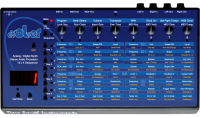
Dave Smith
evolver
The Evolver, Dave Smith Instruments' first product, is a monophonic hybrid synth that marks Dave Smith's return to the world of hardware synthesizers. Featuring two analog DCOs and two wavetable oscillators, the Evolver also harnesses the power of the analog Curtis filter and its complex modulation matrix of 24 sources and over 75 destinations. The Evolver also features three synchronizable delays, a 4-track 16-step sequencer, 512 editable patches, poly in/out/transfer/chain, and stereo inputs and outputs.The Evolver Mono Keyboard from Dave Smith Instruments adds a 3-octave keyboard and pitch and modulation wheels to the Evolver Hybrid Mono module. The Evolver Mono Keyboard allows for easier performance thanks to the velocity and aftertouch sensitive keyboard, as well as more knobs that expose parameters previously only accessible via the Evolver's menus.The Evolver marked Dave's Smith's triumphant return to hardware synths and is still the gold standard for sonic ferocity in a monosynth. It contains a plethora of Dave's best ideas in a monstrously powerful instrument with a unique sound.The Evolver's unique tone comes from the synergy of its two analog oscillators and two digital oscillators (which take the waves from the legendary Prophet VS). Curtis' classic analog low-pass filters and true analog VCAs add warmth and fullness to the analog section, while the digital high-pass filter, tuned feedback, and digital distortion add sizzle and grit. But what really sets the Evolver apart is the way the analog and digital parts of its personality fit together in a true stereo signal path. The word "massive" doesn't begin to describe the Evolver's sound.Imagine being able to move effortlessly from analog smoothness to digital sharpness, or anywhere in between, and you'll begin to understand. The LFOs, step sequencer, and three separate delays can all be synchronized to create complex, scalable, rhythmic, and time-based effects in true stereo.It's a sound designer's dream that can go from ultra-creamy to ultra-aggressive with the turn of a knob. If you need to be convinced, just listen to the demos.
488,00 €
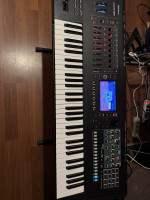
Roland
Fantom 6
Expand your horizon. FANTOMs continue to grow and evolve with new sounds and features added regularly. Roland Cloud offers dozens of Sound Packs and Modeling Extensions that keep your music fresh, while regular updates bring new features and user-requested improvements to enhance the FANTOM experience. Modeling Extensions are available for the following instruments: - ZENOLOGY and ZENOLOGY Pro - JUPITER-X and JUPITER-Xm - FANTOM range Maximum creativity for a more complete experience No more complex modes and menus, its operation is optimized to make the experience more fluid and fast. Create and shape your compositions instantly. A creative process that integrates seamlessly with any computer. The Fantom's maximum creativity mode is always active, no more need to go through menus and sub-menus to overcome technical problems, you'll be efficient wherever you play. No sound compromises, no more technical limits, let your ideas guide you and focus on creating! A sound generator without equal With 40 years of expertise in sound creation, the Fantom's generator integrates both classic and modern sounds. With its Behavior Modelling processors, this workstation offers precise, flexible controls, wide polyphony and multiple patches. Above all, the Fantom is a scalable platform, ready to accommodate future sounds and features. After packing all kinds of technology and sound quality, what could be more important than the feeling of an instrument that responds to your fingers and lets you express yourself fully? The Fantom features Roland's finest keyboards, including the famous PHA-50 for the 88-key version, and an all-new semi-weighted keyboard for the 61- and 76-key versions. The Fantom workstation excels in its speed of creation and arrangement. With its RGB pads, TR-REC sequencer, real-time recording with Piano-Roll, as well as a recording grid and clip launch, you'll be able to perform your compositions. The TR-REC sequencer has been upgraded on the Fantom and features step subdivisions, step automation and chord management.The Fantom doesn't stop there, it can control software synthesizers directly from its touch screen, modular synths or analog synths via its dual CV/Gate output. It is a real high quality audio interface with 16 stereo outputs and 3 stereo inputs. A real platform capable of increasing its power when connected to another device!
2 450,00 €
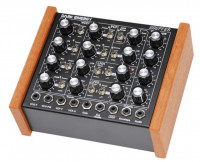
Doepfer
Dark energy II
The new Dark Energy II looks like the Dark Energy I at first sight. But the basic sound of the Dark Energy II is clearly different from the version I because of the new circuits for the VCO, the VCF and the VCA. In the following description of the Dark Energy II, the differences with the Dark Energy I are marked in blue:The Dark Energy II is a stand-alone monophonic synthesizer with USB and Midi interface. The sound generation and all the modulation sources are 100% analog, only the USB/Midi interface contains digital components. The Dark Energy is built in a robust black metal case with wooden side plates. High quality potentiometers with metal shafts are used and every potentiometer - except the filter mode control - is fixed to the case (no wobbly shafts and knobs). The distance between the controls is a bit larger compared to the A-100 modules and vintage looking knobs are used.
300,00 €
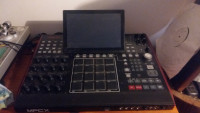
Akai Pro
MPC X
Sampler and without reproach.The return of the MPC, a re-imagined sequencer and sampler while retaining the ergonomics for which it is known, induces autonomy functionality, CV outputs, audio track recording, clip launching, MPC 2.0 software and a 10.1" high definition multitouch tilting screen. It's the largest screen ever used on an MPC, so you can immerse yourself in an intuitive world.Advanced controls.Precisely designed to enhance your creativity, the MPC X's arsenal of hardware controls redefine the standard for the studio's centerpiece. 16 backlit, velocity- and pressure-sensitive RGB pads faithfully capture every nuance of your performance. The 16 touch-sensitive 360-degree Q-links knobs with oLed displays fit perfectly with customizable assignments, while the 66 buttons provide direct, personalized hardware access.The beating heart of your studio.As the hub of your creativity, the MPC X offers an array of studio-quality inputs and outputs. The 8 balanced outputs, which can connect to virtually any peripheral equipment in your studio, and its combination of inputs make it easy to adapt to any setup.Versatility is not an empty word.Whether you prefer to work directly on the MPC or dream of a wild production, the MPC X can be both a standalone production station and a powerful midi controller. In standalone mode, it's powered by the revamped MPC 2.0 software. Connect the MPC-X to your Mac or PC, run the MPC software as a plug-in in the DAW of your choice or as a stand-alone application and harness the power of the VST instruments and effects.Expandable storage but not only.The MPC X comes standard with 16GB of storage, but its 2.5" SATA connector allows for expansion via a hard drive or SSD. In addition, sounds can be accessed and added to the library using the built-in SD card reader or a USB stick. You can also easily manage the power of your sound modules, drum machines and other synthesizers thanks to the countless connections available: 2-in/4-out Midi interface, 8 CV outputs, 2 USB 2.0 inputs, etc.With a design that is often reproduced, but never equaled, the MPC X offers users a stand-alone sequencer/sampler with an intuitive interface, combined with state-of-the-art features that users demand. Don't settle for an imitation, take control of your creative output with the MPC X.The MPC X takes advantage of MPC Software 2.0, the update to Akai Professional's popular software. MPC Software 2.0 can be used in standalone mode, but it can also be used as a plug-in for all popular DAWs on Mac and PC, or as a standalone application. Find out everything you need to know about the new features offered by the latest versions v2.3 and v2.4.With the MPC 2.9 update, the MPC X comes with the DrumSynth drum synthesis plugin, a powerful drum synthesis design and modeling tool featuring 8 individual generators and many built-in audio effects, to best accompany all your compositions.
1 200,00 €
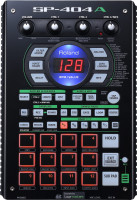
Roland
SP-404A
Designed for the stage, the SP-404A Linear Waveform Sampler expands the sonic horizon of the Roland AIRA TR-8 Rhythm Performer by combining percussive synthesis with samples. The popular fast and direct handling of the SP series samplers complements the rhythm effects and step sequencer of the Roland AIRA TR-8 perfectly.The SP-404A offers all the features of the acclaimed SP-404SX, including 16-bit linear sampling, 29 internal effects, smooth switching between effects, and 12 professional-quality playing pads. In addition, the SP-404SX comes with an SD card-based sound library from industry leader Loopmasters.Whether you use it as a stand-alone unit or control it from the TR-8, the SP-404A is sure to expand the possibilities of your AIRA instruments. This is a new must-have for DJs, musicians and producers.
499,00 €
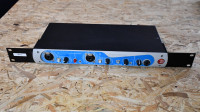
Digidesign
Digi 001
In the early 2000s, the world of computer audio was just beginning to blossom for home users and small studios. Hardware was becoming more accessible and the power and speed of computers were beginning to reach a level where it was possible to make a decent amount of multitrack recordings with fairly large sessions. The launch of the 001 changed things dramatically, and it was suddenly possible to use Pro Tools much more extensively. The 001 consisted of a PCI card that connected to a 1U rackmount box via a multi-pin umbilical cable that had 8 analog inputs and outputs (the first two channels had mic/line preamps on XLR/Jack Combi jacks). An additional 8 channels were available via optical ADAT ports on the PCI card, plus stereo coaxial Spdiff and MIDI io's on the rear of the case. If you paired the 001 with an 8-channel ADAT converter, you had 16 analog io's and could record an entire tape at once, which was big enough for non-TDM Pro Toolers at the time.
30,00 €
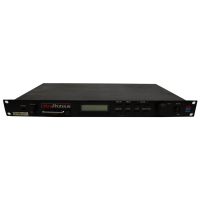
E-MU
E-MU - Ultra Proteus
High quality samples, very powerful filtering. A studio beast in 1U 19" Rack format. Optional front panel sound cards are still available. 14500 Francs in 1994. A very nice opportunity at a good price-quality ratio nowadays. 297 "Z-Plane" filters including flangers, parametric, translation, etc. A few notes and we understand all the E-MU genius.
199,00 €
250,00 €
-20%
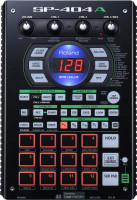
Roland
SP-404A
THE LEGENDARY SAMPLER JOINS FORCES WITH AN ICONIC SEQUENCER Designed for the stage, the SP-404A Linear Waveform Sampler expands the sound horizon of the Roland AIRA TR-8 Rhythm Performer through a combination of percussive synthesis with sampled sound. The fast, direct handling that is so popular with the SP Series samplers complements the Roland AIRA TR-8 Rhythm Performer's rhythm effects and step sequencer. The SP-404A offers all the features of the popular SP-404SX, including 16-bit linear sampling, 29 internal effects, smooth switching between effects, and 12 professional-quality performance pads. In addition, a sound library prepared by the industry leader, Loopmasters, is provided on an SD card. Whether you use it standalone or control it from the TR-8, the SP-404A is sure to expand the possibilities of your AIRA instruments. This is a new must-have for DJs, musicians and producers.
449,00 €
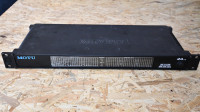
Motu
24 I/O
The MOTU Audio 24I/O interface fulfills the promise of host-based hard disk recording: recording, editing, mixing and mastering multitrack recording projects entirely inside the computer. It provides 24 high-quality, 24-bit/96kHz analog inputs and outputs in a single rack-space, cost-effective package, allowing you to connect and record from up to 24 simultaneous analog sources. The MOTU 24I/O can be purchased as an expansion for an existing PCI-424-based MOTU audio system, or as a base system that includes the PCI-424 card and Audiodesk workstation software. This is the complete base system, not just the expander interface.
600,00 €
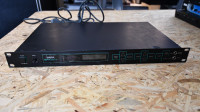
Yamaha
SPX90 II
One year after the success of the original Yamaha SPX-90 (released in late 1985/early 1986), Yamaha launched the Yamaha SPX-90II. The two processors are identical in terms of specifications and effects offered, the only difference is that the Yamaha SPX-90II has twice as much memory for delays. The Yamaha SPX-90II is a blend of advanced acoustic research and digital technology designed to offer musicians and home recording enthusiasts a wide range of exciting effects. The Yamaha SPX-90II digital multi-effects processor uses highly refined Large Scale-Integration (LSI) technology to create natural reverberation. Not only is its assortment of 30 presets complete enough to suit most studio and performance applications, the SPX90II also allows you to create up to 60 additional effects and store them for instant recall. The SPX90II can create effects that go beyond simple reverb, although the quality of the reverb itself is truly superior. A variety of echo, delay and special effects - each with full parameter settings - are accessible at the touch of a button. And because the SPX90II is MIDI compatible, it can be programmed to apply separate reverb effects to a variety of MIDI-compatible instruments. The Yamaha SPX90II digital multi-effects processor is extremely useful in a wide variety of applications: acoustic, electric, PA, MIDI instruments, and home recording systems.
89,00 €
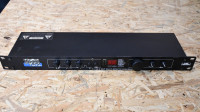
DigiTech
Studio Twin
Based on S-DISC (TM) processing technology, the true stereo effects processor uses a 44.1 kHz sample rate and 18-bit conversion to provide a myriad of tools including stereo reverbs, multi-tap delays, choruses, flashes, tremolos, detuning, and parametric equalizers. With 99 factory programs included, up to 99 user-defined program combinations can be easily edited and recorded via the Studio Twin's simple user interface. The processor also responds to MIDI, so programs can be changed on the fly via a simple user interface.
100,00 €
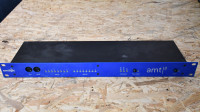
Emagic
AMT8
The Emagic AMT8 (Active MIDI Transmitter 8) is a professional MIDI interface designed in 1997 for time-proven live and studio applications. Created by the same company that originally created the ubiquitous DAW Logic, the AMT8 has 8 MIDI inputs and outputs, with scalability up to 64 inputs/outputs for a total of 1024 MIDI channels. LED indicator lights provide real-time feedback for all 8 channels, easily visible in fast-paced concert scenarios and studio sessions. The AMT8 is fully compatible with any standard MIDI software on Mac and Windows 95/98 (drivers for Windows NT and Windows 2000 are under development). With its full range of connectors such as USB for Mac and Windows, RS232 (Windows) and RS422 (Mac), the AMT8 integrates quickly into any computer environment. Up to eight * devices can be stacked and they will only work as a big 64 x 64 MIDI interface (Mac: Emagic software or Unitor8 SGD driver required) with AMT technology to ensure razor-sharp synchronization on each port. AMT8 and Unitor8 can be combined in any combination; this allows, for example, the connection of a non-USB Unitor8 from a computer with USB via an AMT8.
70,00 €

Roland
Fantom 8
The Roland FANTOM is a powerful and impressive synthesizer workstation with sequencer, sampler, audio interface and extensive synthesizer functions. In the generously sized and expandable sound memory, Roland has literally immortalized a best-of 40 years of synthesizer history and integrated its high-quality V-Piano for all keyboard virtuosos. In addition to multiple synthesis technologies that can be used simultaneously, you can keep in mind that the FANTOM's analog multi-mode filter can be the icing on the cake for some sounds. The sequencer offers real-time sequencing, TR/step sequencing and a clip sequencer. OneShots and loops can be playfully triggered via the sampler pads and integrated into your own creations.Another highlight of the FANTOM are the scene memorieswhich are organized in four banks with 128 memory locations each. They act as fast creative memories and hold everything you work on. Whether it's a handful of patterns, a song you've started, a sound you're creating, various settings related to your current project in the audio workstation, or all of the above, handwritten notes and "it has to stay on because I can't save it" are a thing of the past.Anyone who has worked with Roland instruments will quickly notice that the operation has been redesigned and leads to faster results, not only because of the neat interface but also because of the Fantom's very intuitive menu navigation.Sounds and synthesisRoland has gone all out with the FANTOM, equipping its flagship product with over 3500 sounds and over 90 drum kits, as well as the very avant-garde V-Piano. Strings, organ, piano, guitar, brass, choir, wind instruments and more: the FANTOM's selection is simply outstanding!The typical Roland sound architecture has been retained in that each sound can be composed of four parts. However, the FANTOM's Parts correspond to a complete and extended synthesizer voice with its own oscillator and filter models, envelopes, modulation assignments and, of course, its own volume and panning controls. There is also a dual LFO for each of the four parts, which not only has the usual waveforms, with and without BPM sync, but you can also create your own waveforms by hand. We calculate: 16 tracks with up to 8 LFOs per sound; 128 LFOs simultaneously! If you like to create new sounds from scratch, this is the source of all modulation ideas.The new and extended architecture allows you to create sounds according to the modular principle: take for example the SuperSaw oscillator (known from the JP-8000) and combine it with the Juno filter; what was previously reserved for modularists, you get here in a storable way! Different synthesis technologies can be defined for each sound and each part, so there's nothing to stop a layered sound of roaring organ, delay-wrapped bells and crisp bass.EffectsA set of 90 multi-effects are just waiting to modify and refine the sounds created, individually or in parallel, respectively in series, per part. The selection of delay, reverb, chorus, flanger, distortion, real one-offs with a wow character, should leave nothing to be desired. Moreover, the Fantom has enough power to calculate elaborate effect chains for each of the 16 tracks without running out of steam. In addition, each part has its own EQ. The master compressor is located above the main output. A special position is given to the analog filter, which offers four different filter types (LPF, BPF, HPF & PKG), including the drive. The filter can be assigned to individual tracks, the main output, a DAW return or the analog inputs. Thus, it is not only an extended part of the sound generation, but also an independent effect to give sounds the final touch in the right place.Sequencer and samplerThe Fantom's sequencer has been completely reworked and now offers parallel recording and composing concepts that perfectly support the "typical" recording methods. Instead of recording all tracks in one pattern "as before", the Fantom offers the possibility to freely combine the 16 tracks and use them independently. The songs can be arranged in the classic linear way or in the clip sequencer (comparable to Ableton Live). The TR/step sequencer, which is also capable of substepping and ratcheting, is ideal for rhythm programming. The perfectly played piano or the funky organ can be recorded in real time, either with or without note quantization. The same applies to the 16 pads, which play individual sounds from the internal sound generator or from their own samples. This pad mode is familiar from the Akai MPC series. Behind the pads is also the sampler; with 8-fold polyphony, four banks of 16 pads each can be assigned. Sounds and loops can be up to 2 GB in size, time stretching is of course also offered for loops. A comprehensive Arpeggiator and a chord memory function are also part of the Fantom's sophisticated playback aids.Full integration in a DAWThe FANTOM can be fully integrated into the workflow of a DAW (e.g. Apple Logic Pro, GarageBand, MainStage). Thanks to the USB audio interface, 16 stereo tracks can be recorded, edited and, most importantly, processed in parallel in the computer. Three stereo tracks can be addressed from the DAW to the FANTOM, either to edit a track with the analog filter or as an audio output from the DAW to the main mixer. Plug-ins loaded in the DAW can be easily used and edited from the FANTOM, including song position pointers and the entire DAW transport field. DAW and plug-in commands are also stored in the scenes and can be recalled in seconds, provided the computer is connected and the DAW is open. Otherwise, this data is not taken into account when loading.Thanks to several USB ports, it is of course possible to connect other devices in addition to a computer and an external storage medium such as a USB stick. For example, you can connect a second keyboard for two-handed play, a Breath controller or a fader box.System update 2.1The highlights of the new OS 2.1 are the four expansion slots, which can be equipped with expansions of popular and historical Roland synthesizer models. The four timeless classics Jupiter-8, Juno-106, SH-101, and JX-8P mark the beginning of an ever-evolving series. Best of all, the update, which includes a number of bug fixes and improvements, is available for free to all Fantom 6/7/8 owners, as well as the four cult synths!The instruments themselves can be combined in the usual way with the state-of-the-art Zen Core synthesis, V-Piano sounds or for example your own multi-samples. Moreover, each of the four synthesizers is presented with its own interface and of course with the controls of the corresponding originals. Thanks to the Zenology platform, you have access to this huge variety of sounds everywhere.
3 499,00 €
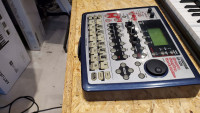
Boss
SP-505 Groove Sampling Station
The SP-505 is an advanced entry-level sampling workstation aimed at the electronic, hip hop and dance market that fits somewhere in between the economical BOSS SP-303 and the professional Roland SP-808. The SP-505 is centered around working with one-shot samples, loops, grooves and drum beats through a fairly basic set of sampling, sequencing and performance-oriented features. The machine has 8 voices of polyphony and 4MB of internal sample memory that can contain up to 250 samples organized among 16 sound banks (4 preset and 12 user). Sampling specs are limited to CD-quality 44.1 kHz (which yields about 2 minutes of sample-time) as well as 22.050 and 11.025 kHz sample rates (more sample time, but less sound quality)
300,00 €
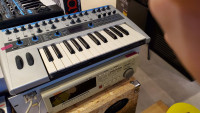
Novation
K-Station
The K-Station is a whole new take on the original Bass Station Keyboard that put British synth makers Novation on the analog synth map! Essentially, the K-Station is an extremely well laid-out and superbly designed 2-octave keyboard version of their new A-Station rack module. It features 8 voices of analog modeled sounds with FM, 12-band vocoder, arpeggiator, reverb and delay effects, 400 user rewritable program memories, and more. Unlike the crowded interface and puny LCD display screen found on the A-Station, the K-Station has a beautiful layout with easy access to its knobs, sliders and buttons. And finally there's a large LCD display!
200,00 €
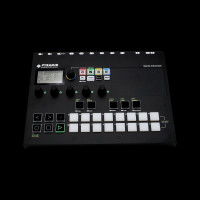
Squarp Instruments
Pyramid
Pyramid MKIII : A new workflowModern, easy-to-use & versatile hardware sequencer.Pyramid provides you with a radical new workflow and almost unlimited possibilities.It will become your ultimate studio centerpiece.100% standalone :Pyramid is designed to be the perfect brain for your musical setup, from studio to stage. It brings together a powerful sequencer, a looper, a rhythm generator, a real-time effect processor, a midi controller and an input+output interface.Pyramid does not produce sounds. Instead, we have focused our energies on creating an innovative and complete sequencing solution full of creative tools.Pyramid is an instant source of inspiration to start, finish & perform your song!Connect your modern and vintage instruments straight out of the box.Full connectivity : midi in/out, midi usb in/out, cv gate in/out, din sync out, footswitch.Hardware & computer hub :With Pyramid's high precision clock, the sequencer becomes a great synchronisation tool for both vintage and recent devices. Your instruments will always keep in time: Pyramid is the heartbeat of your studio.You can also use Pyramid sequencer as a rock-solid interface box for your MIDI, USB MIDI & CV/GATE setup: filter note/clock/start stop/cc/pitch/aftertouch messages, route MIDI in to USB MIDI out,convert MIDI in to CV/GATE output and add effects, convert CV/GATE in to MIDI out, convert MIDI IN clock to DIN SYNC...Even if you use a DAW as your primary sequencer, Pyramid will become an indispensable Swiss army knife!Play your sequencer! Push, rotate, slide & draw.Capture your inspirationRecord a performance at any time with the built-in keyboard, the smartpads (generates chords, scales or repeats), the touchpad, the 5 encoders or an external controller... with true polyphony and high precision!You can even use the midi looper mode, in the style of audio looper pedals. Live improvisation recording has never been so easy!Create polyphonic melodies & rhythms with the advanced step sequencerCreate and arrange complex rhythms and melodies with the full realtime step sequencer, or edit your live recording. The piano roll view clarifies notes and drums programming. Change the pitch, the velocity, the width and the offset of each note, in a flash. Zoom in (up to 1600%) to surgically edit the track. As Pyramid is fully polyphonic, a step can contain an unlimited number of notes!Draw automationCreate CC or FX automation with the touchpad or with the 16 pads.Create an infinite number of automation per track! Slide the touchpad to draw the automation, or use the 16 pads to edit or add step-lock parameters.Generate outstanding euclidean groovesPyramid offers one algorithmic euclidean sequencer engine per track, auto generating uncommon and rich rhythmic patterns. Almost all traditional rhythms from across the world can be generated with this tool.Change the number of total steps, the number of filled steps, the step width, rotate the pattern, all of this on the fly. The displayed euclidean circle helps you to visualize the pattern.Deeply play with your tracksOnce your tracks are created, Pyramid offers several ways to play with your sequences: mute/unmute your 64 tracks on the fly, launch sequences (group of tracks), or chain sequences to create a complete, structured song.You can choose to perform your tracks and sequences in sync (1 bar, 2 bars, ...) or not. It's even possible to play in sync with one beat resolution, a new way to improvise with sequences!Flexible interfacePyramid includes 5 clickable encoders and a wide touchpad.You can easily assign any of these controls to an effect parameter or a midi CC message by pressing the "assign" button, and recording the automation. Even the two CV analog inputs can be assigned – it's up to your imagination!PyraOS realtime processing system unleashes your creativityControl any parameters on the fly and listen to the changes immediately. Never stop anything: change the length of a track, the MIDI channel, the quantization grid, the swing percentage, the arpeggiator rate, the delay on/off... in a flash and go experi-mental!Everything is at your fingertips.
742,80 €
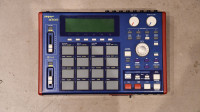
Akai Pro
MPC 1000
The MPC1000 inherits all the essential MPC features, such as 32-voice stereo sampling, 64-track sequencing, and 16 MPC velocity- and pressure-sensitive pads, by integrating all the production capabilities into a compact and affordable package. 16 MB of onboard memory comes standard and can be expanded up to 128 MB. You can save your work to a standard Compact Flash card (up to 2 GB). A CF card preloaded with popular Akai Pro samples is included to get you started.When connected to a Mac or PC via its built-in USB port, you can simply drag and drop data between the computer and the MPC1000 CF card. The MPC1000 is small, rugged, and incredibly portable to easily slip into a backpack or laptop bag for the producer on the go.
390,00 €

Korg
PA4X-61
The new Korg PA-4X professional arranger is an indispensable instrument for composing, recording, performing and entertaining. The Pa4X professional arranger is more than a keyboard, it's your band, your accompanist, your artistic director and even your sound engineer.More than just recorded soundsThe huge sound bank includes classical and contemporary keyboard sounds as well as brass and classical orchestra sounds including a new multi-layer stereo grand piano sound (with sampling of the forte pedal and soundboard resonance) as well as new electric piano sounds, wind instruments, basses and incredible acoustic and electric guitars. In addition, there are harmonic drawbar organ sounds with the reproduction of the cab's breath and the sound of the keys.A state-of-the-art technology.These sounds were captured with Korg's own state-of-the-art EDS-X (Enhanced Definition Synthesis-eXpanded) technology, which reproduces even the smallest nuances with extraordinary precision. The integrated sampler and sound editor allow you to fill the extensive user memory with your own or imported sounds.Subtle nuances of expression.All of these sounds come to life with the Korg DNC (Defined Nuance Control) system, which allows the musician to introduce subtle nuances and expressive sound articulations. For example, the joystick, ribbon and assignable switches add the buzz of a saxophone, the breathy nuances of a trumpet, clarinet or harmonica, and accentuate the authenticity of plucked or bowed strings. You can even hear the keys open as the saxophone notes rise and close as the notes fade.Natural, authentic sounds.Every sound on the Pa4X runs through separate effects processors and EQs, so you can fine-tune your sound before sending it to the stereo audio outputs. Effects range from classic reverbs and delays to less classic effects like a vocoder, realistic amp simulators and amazingly realistic vintage effects. With the included Waves Audio MAXX effects suite, you'll get a more powerful, clearer, richer and more finished sound when mastering.For those who love hi-fi.If you're looking for high fidelity, you can add the PaAS amplifier system to the Pa4X, specifically designed to be connected directly to the keyboard. Impressive at home or as a stage monitor, the PaAS requires no additional stand, cable or power supply to deliver crystal-clear sound at any volume level, allowing the musician to play at any time without disturbing the neighborhood.A band at your disposal.The Pa4X's ultra-realistic sounds are suitable for any style of music. And you can add to them by creating your own styles, customizing the templates provided or converting Midi File songs into styles. Your chords can be followed by up to eight accompaniment parts, and Auto Fill automatically provides a transition, so you'll get the feeling of having a band ready to play at any time. The Chord Sequencer function records your chord progressions in real time and you can save them in Styles and SongBook entries to play along with your chords, which is handy for practice or to free up your left hand.Listen to and save songs.Listen to songs in .MID and .MP3 format with Korg's patented XDS dual sequencer/player with crossfade. Songs and Styles can display lyrics for the singer and chords for the guitarist, and even on an external display via the video output. Any track in a Midi song can be displayed on a score. Markers allow you to return to the beginning of a passage to repeat during your work sessions. Better yet, record what you play and sing as an .MP3 file to listen to anywhere, even in the car! You can also re-record an MP3 file to make a multi-track recording...Success guaranteed on stage or at home.The Pa4X is a compact and lightweight arranger that will easily find its place on stage. If you add the optional stand (KOC PA3XSTAND-BK), it will fit perfectly in your home. The programmable metronome can be used as a guide during practice and as a click for the other band members if you send it through separate outputs to the stage monitors or headphones.For... musicians!The 76- or 61-key semi-weighted keyboards are designed for musicians of all skill levels, offering realistic feel and perfect expression control. Tiltable for a perfect display in all circumstances, the explicit interface of its touch screen is based on icons representing real objects, the Pa4X is a real musical instrument intended for musicians above all.
2 569,00 €
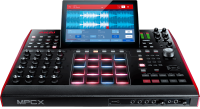
Akai Pro
MPC X
Sampler and without reproach.The return of the MPC, a re-imagined sequencer and sampler while retaining the ergonomics for which it is known, induces autonomy functionality, CV outputs, audio track recording, clip launching, MPC 2.0 software and a 10.1" high definition multitouch tilting screen. It's the largest screen ever used on an MPC, so you can immerse yourself in an intuitive world.Advanced controls.Precisely designed to enhance your creativity, the MPC X's arsenal of hardware controls redefine the standard for the studio's centerpiece. 16 backlit, velocity- and pressure-sensitive RGB pads faithfully capture every nuance of your performance. The 16 touch-sensitive 360-degree Q-links knobs with oLed displays fit perfectly with customizable assignments, while the 66 buttons provide direct, personalized hardware access.The beating heart of your studio.As the hub of your creativity, the MPC X offers an array of studio-quality inputs and outputs. The 8 balanced outputs, which can connect to virtually any peripheral equipment in your studio, and its combination of inputs make it easy to adapt to any setup.Versatility is not an empty word.Whether you prefer to work directly on the MPC or dream of a wild production, the MPC X can be both a standalone production station and a powerful midi controller. In standalone mode, it's powered by the revamped MPC 2.0 software. Connect the MPC-X to your Mac or PC, run the MPC software as a plug-in in the DAW of your choice or as a stand-alone application and harness the power of the VST instruments and effects.Expandable storage but not only.The MPC X comes standard with 16GB of storage, but its 2.5" SATA connector allows for expansion via a hard drive or SSD. In addition, sounds can be accessed and added to the library using the built-in SD card reader or a USB stick. You can also easily manage the power of your sound modules, drum machines and other synthesizers thanks to the countless connections available: 2-in/4-out Midi interface, 8 CV outputs, 2 USB 2.0 inputs, etc.With a design that is often reproduced, but never equaled, the MPC X offers users a stand-alone sequencer/sampler with an intuitive interface, combined with state-of-the-art features that users demand. Don't settle for an imitation, take control of your creative output with the MPC X.The MPC X takes advantage of MPC Software 2.0, the update to Akai Professional's popular software. MPC Software 2.0 can be used in standalone mode, but it can also be used as a plug-in for all popular DAWs on Mac and PC, or as a standalone application. Find out everything you need to know about the new features offered by the latest versions v2.3 and v2.4.With the MPC 2.9 update, the MPC X comes with the DrumSynth drum synthesis plugin, a powerful drum synthesis design and modeling tool featuring 8 individual generators and many built-in audio effects, to best accompany all your compositions.
1 745,00 €

Roland
Fantom 6
Expand your horizon. FANTOMs continue to grow and evolve with new sounds and features added regularly. Roland Cloud offers dozens of Sound Packs and Modeling Extensions that keep your music fresh, while regular updates bring new features and user-requested improvements to enhance the FANTOM experience. Modeling Extensions are available for the following instruments: - ZENOLOGY and ZENOLOGY Pro - JUPITER-X and JUPITER-Xm - FANTOM range Maximum creativity for a more complete experience No more complex modes and menus, its operation is optimized to make the experience more fluid and fast. Create and shape your compositions instantly. A creative process that integrates seamlessly with any computer. The Fantom's maximum creativity mode is always active, no more need to go through menus and sub-menus to overcome technical problems, you'll be efficient wherever you play. No sound compromises, no more technical limits, let your ideas guide you and focus on creating! A sound generator without equal With 40 years of expertise in sound creation, the Fantom's generator integrates both classic and modern sounds. With its Behavior Modelling processors, this workstation offers precise, flexible controls, wide polyphony and multiple patches. Above all, the Fantom is a scalable platform, ready to accommodate future sounds and features. After packing all kinds of technology and sound quality, what could be more important than the feeling of an instrument that responds to your fingers and lets you express yourself fully? The Fantom features Roland's finest keyboards, including the famous PHA-50 for the 88-key version, and an all-new semi-weighted keyboard for the 61- and 76-key versions. The Fantom workstation excels in its speed of creation and arrangement. With its RGB pads, TR-REC sequencer, real-time recording with Piano-Roll, as well as a recording grid and clip launch, you'll be able to perform your compositions. The TR-REC sequencer has been upgraded on the Fantom and features step subdivisions, step automation and chord management.The Fantom doesn't stop there, it can control software synthesizers directly from its touch screen, modular synths or analog synths via its dual CV/Gate output. It is a real high quality audio interface with 16 stereo outputs and 3 stereo inputs. A real platform capable of increasing its power when connected to another device!
2 799,00 €
3 282,00 €
-15%

